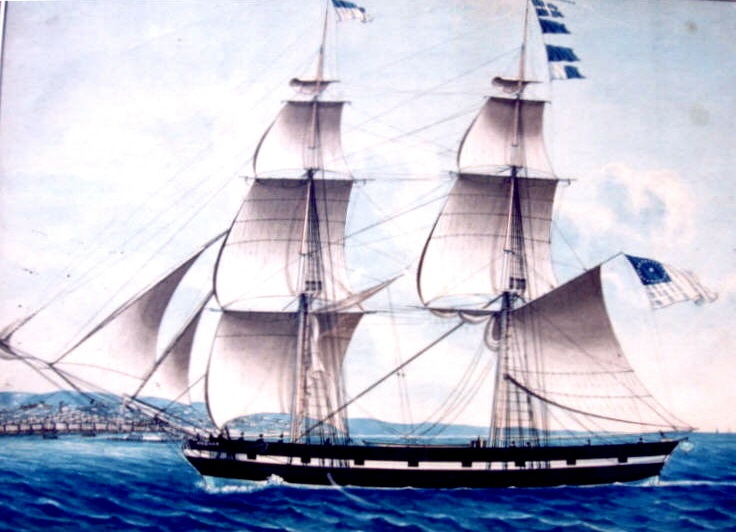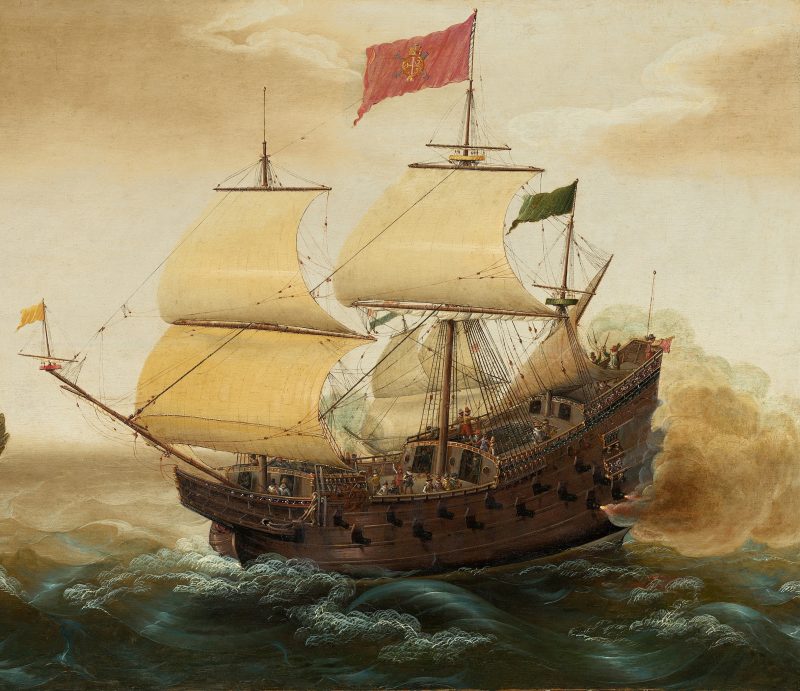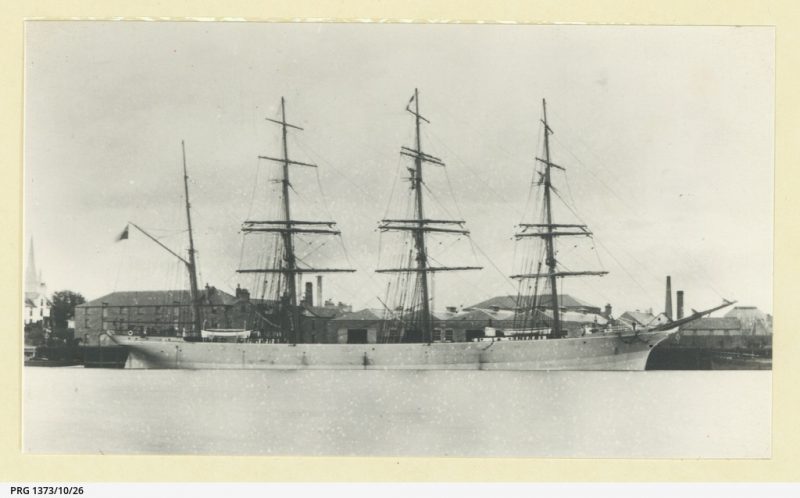The two-masted brig was one of the types of sailing ships that met their demise off Sea Isle City, then known as Ludlam's Island. (Courtesy of Wikipedia)
 By BOB THIBAULT
Ever since Christopher Columbus bumped into San Salvador on Columbus Day in 1492, deep-sea navigational tools have been capable of guiding ships all the way across the ocean.
But these tools were nearly useless, especially in the early days, along coastlines like that of New Jersey. When sailing within about 20 miles of land, a ship’s master had to rely on his own eyes, aided by a simple compass and prior charts of landmarks, shoals, water depths, and tide directions.
Imagine trying to juggle all this in real time in the face of a sail-shredding, 80 mph nor’easter with zero visibility in a driving snowstorm. No wonder there were wrecks.
Ludlam’s Island had its fair share. In the 18th and 19th centuries, thousands of ships skirted the island from Townsend’s Inlet to Corson’s Inlet. Some didn’t make it. It wasn’t until the mid-1850s, when the Townsend’s Inlet Life Saving Station came into being, that any kind of systematic record was kept.
Before that, there simply weren’t a lot of people around to observe, let alone record, the shipwrecks that must have occurred regularly. Documentation has survived on only a handful of wrecks from those very early days, and some of that is pretty sketchy.
We don’t have images of the specific vessels involved, but we can get a fair idea from paintings and models of contemporary ships with similar characteristics. This is the story of those wrecks, some nearly forgotten – noted by just a single line in a database.
Fame (1781):
Two hundred and forty years ago, the American privateer Fame, under command of a man named William Treen, capsized in a heavy gale off the Jersey coast. Fame was a two-masted, privately owned brig, originally commissioned by the U.S. Government to attack and seize British ships during the Revolutionary War.
On February 22, 1781, heavily laden with plunder, she sank to the bottom of the sea, taking 20 mariners with her. (1)
The story of the Fame may not have ended with her demise in 1781. She was originally reported to have sunk off Peck’s Beach (now Ocean City), but evidence has since surfaced that places the event farther south.
On July 8, 2012, it was reported that after a dredging operation dumped sand from Corson’s Inlet onto Strathmere Beach, Spanish reales and doubloons began to pop up on the beach – with none dated later than 1781.
The author concluded that the source of this treasure was the Fame, and that she indeed had gone down in Corson’s Inlet. (2). If so, this was probably the first documented shipwreck in the history of Ludlam’s Island.
Minerva (1791):
The ship Minerva was stranded and left derelict in March 1791, on the shore of what was to become Sea Isle City. She was carrying a cargo of spices, tea, coffee and silk, which implies she was sailing from the Orient, probably headed for New York City. The fate of Minerva’s crew and her cargo is unknown. (1)
By BOB THIBAULT
Ever since Christopher Columbus bumped into San Salvador on Columbus Day in 1492, deep-sea navigational tools have been capable of guiding ships all the way across the ocean.
But these tools were nearly useless, especially in the early days, along coastlines like that of New Jersey. When sailing within about 20 miles of land, a ship’s master had to rely on his own eyes, aided by a simple compass and prior charts of landmarks, shoals, water depths, and tide directions.
Imagine trying to juggle all this in real time in the face of a sail-shredding, 80 mph nor’easter with zero visibility in a driving snowstorm. No wonder there were wrecks.
Ludlam’s Island had its fair share. In the 18th and 19th centuries, thousands of ships skirted the island from Townsend’s Inlet to Corson’s Inlet. Some didn’t make it. It wasn’t until the mid-1850s, when the Townsend’s Inlet Life Saving Station came into being, that any kind of systematic record was kept.
Before that, there simply weren’t a lot of people around to observe, let alone record, the shipwrecks that must have occurred regularly. Documentation has survived on only a handful of wrecks from those very early days, and some of that is pretty sketchy.
We don’t have images of the specific vessels involved, but we can get a fair idea from paintings and models of contemporary ships with similar characteristics. This is the story of those wrecks, some nearly forgotten – noted by just a single line in a database.
Fame (1781):
Two hundred and forty years ago, the American privateer Fame, under command of a man named William Treen, capsized in a heavy gale off the Jersey coast. Fame was a two-masted, privately owned brig, originally commissioned by the U.S. Government to attack and seize British ships during the Revolutionary War.
On February 22, 1781, heavily laden with plunder, she sank to the bottom of the sea, taking 20 mariners with her. (1)
The story of the Fame may not have ended with her demise in 1781. She was originally reported to have sunk off Peck’s Beach (now Ocean City), but evidence has since surfaced that places the event farther south.
On July 8, 2012, it was reported that after a dredging operation dumped sand from Corson’s Inlet onto Strathmere Beach, Spanish reales and doubloons began to pop up on the beach – with none dated later than 1781.
The author concluded that the source of this treasure was the Fame, and that she indeed had gone down in Corson’s Inlet. (2). If so, this was probably the first documented shipwreck in the history of Ludlam’s Island.
Minerva (1791):
The ship Minerva was stranded and left derelict in March 1791, on the shore of what was to become Sea Isle City. She was carrying a cargo of spices, tea, coffee and silk, which implies she was sailing from the Orient, probably headed for New York City. The fate of Minerva’s crew and her cargo is unknown. (1)
 The Spanish galleon was another type of ship that sank in waters off Ludlam's Island. (Courtesy of Wikimedia Commons)
Montezuma (1797):
The Montezuma, a Spanish galleon on its way from Mexico to Spain laden with a million dollars in gold and silver, sank during a storm a few miles off the coast of Townsend’s Inlet in 1797. After a century of searching, the sunken ship and its cargo still hadn’t been found. (3)
Since then, there appears to be no record. It’s odd that there seems to be just a single reference to this potentially very profitable mishap.
Guatamazon (1809):
The following story was pieced together from several sources. (1,3,4,5,6,7). The Guatamazon (or “Guatamoozin” as she was known to the locals) was a three-masted, full-rigged ship flying the British flag. Such a ship was usually the largest and most prestigious in the complement of any global maritime fleet.
The story of the Guatamazon is well-documented. On a day in February 1809, this imposing ship, bound from Canton, China, to New York City with a cargo of tea and silks, ran into trouble near Townsend’s Inlet.
She had been driven there by a fierce nor’easter with visibility shrouded by a swirling snowstorm. She was finally grounded on the south side of the inlet. A landing party went ashore and was greeted by – pretty much nothing.
They had no idea where they were, and began wandering around in two feet of snow, lost among the cedar trees and sand dunes of Seven Mile Island.
Then a miracle happened. Three men from the mainland – Humphrey Swain, Nathaniel Stites, and Zebulon Stites – happened to be in the same desolate neighborhood trying to bag a few ducks, when they noticed footprints in the snow that weren’t theirs.
They followed the prints and eventually found the ship’s party shivering in the lee of a sand dune.
The alarm went out. Farmers from the mainland rushed to see the great ship, to help, and most likely to look over the array of silks that had washed to the beach. The scene was later described as “a frenzy.”
Most of the damaged silks, and even the tea, eventually made it to New York, but the ship’s loss was estimated at more than $50,000.
In large part through the efforts of the three duck hunters, the entire crew was eventually rescued, warmed, and fed in the hunters’ makeshift hut.
Then the Guatamazon lifted herself on a giant wave, came down with a thud, and literally went to pieces.
Maria (1820):
The ship Maria was stranded in Townsend’s Inlet in March 1820, on a voyage from Matanas, Cuba to an unknown port. (1) Her ultimate fate is unknown.
Hunter (1824):
The Spanish galleon was another type of ship that sank in waters off Ludlam's Island. (Courtesy of Wikimedia Commons)
Montezuma (1797):
The Montezuma, a Spanish galleon on its way from Mexico to Spain laden with a million dollars in gold and silver, sank during a storm a few miles off the coast of Townsend’s Inlet in 1797. After a century of searching, the sunken ship and its cargo still hadn’t been found. (3)
Since then, there appears to be no record. It’s odd that there seems to be just a single reference to this potentially very profitable mishap.
Guatamazon (1809):
The following story was pieced together from several sources. (1,3,4,5,6,7). The Guatamazon (or “Guatamoozin” as she was known to the locals) was a three-masted, full-rigged ship flying the British flag. Such a ship was usually the largest and most prestigious in the complement of any global maritime fleet.
The story of the Guatamazon is well-documented. On a day in February 1809, this imposing ship, bound from Canton, China, to New York City with a cargo of tea and silks, ran into trouble near Townsend’s Inlet.
She had been driven there by a fierce nor’easter with visibility shrouded by a swirling snowstorm. She was finally grounded on the south side of the inlet. A landing party went ashore and was greeted by – pretty much nothing.
They had no idea where they were, and began wandering around in two feet of snow, lost among the cedar trees and sand dunes of Seven Mile Island.
Then a miracle happened. Three men from the mainland – Humphrey Swain, Nathaniel Stites, and Zebulon Stites – happened to be in the same desolate neighborhood trying to bag a few ducks, when they noticed footprints in the snow that weren’t theirs.
They followed the prints and eventually found the ship’s party shivering in the lee of a sand dune.
The alarm went out. Farmers from the mainland rushed to see the great ship, to help, and most likely to look over the array of silks that had washed to the beach. The scene was later described as “a frenzy.”
Most of the damaged silks, and even the tea, eventually made it to New York, but the ship’s loss was estimated at more than $50,000.
In large part through the efforts of the three duck hunters, the entire crew was eventually rescued, warmed, and fed in the hunters’ makeshift hut.
Then the Guatamazon lifted herself on a giant wave, came down with a thud, and literally went to pieces.
Maria (1820):
The ship Maria was stranded in Townsend’s Inlet in March 1820, on a voyage from Matanas, Cuba to an unknown port. (1) Her ultimate fate is unknown.
Hunter (1824): The Eudora (Courtesy of State Library of South Australia)
Eudora (1849):
The Eudora was, and probably always will be, the largest passenger vessel to be stranded off Ludlam’s Island. She was a 155-foot long, propeller-driven steamship with a total manifest of about 400 passengers and crew.
The event went something like this (1,9,10,11): On a day in mid-November 1849, the Eudora embarked from New York City, bound for San Francisco, loaded with passengers eager to join in the mad rush for California gold.
Only two days out from port, fighting a nor’easter, she somehow managed to ground herself off the coast of Ludlam’s Island. Getting all the passengers and their luggage off the ship was going to be tough. But the U.S. Government came to the rescue – in the form of metallic surf boats, several of which had been placed along the shore in readiness to aid unexpected drop-ins like the Eudora.
Guided by R.C. Holmes, Collector of Customs, all on board were safely brought to shore, along with their luggage and the ship’s cargo. The record of what happened after that is confusing.
The passengers were apparently returned to New York. It’s not clear if they ever got to dig for gold. It’s intimated that the ship herself made it to San Francisco, but if so, what did she carry? Did she really break free from the island, did she return north for repairs, or was she abandoned as a derelict?
The Eudora was the last shipwreck recorded before 1850. Even though there were apparently only ten whose identities have survived, these early records give us an idea of the havoc that Ludlam’s Island, or any shoreline, could visit on the unwary, unsavvy, or just plain unlucky.
This “Spotlight on History” was written by Sea Isle City Historical Society Volunteer Bob Thibault.
References:
The Eudora (Courtesy of State Library of South Australia)
Eudora (1849):
The Eudora was, and probably always will be, the largest passenger vessel to be stranded off Ludlam’s Island. She was a 155-foot long, propeller-driven steamship with a total manifest of about 400 passengers and crew.
The event went something like this (1,9,10,11): On a day in mid-November 1849, the Eudora embarked from New York City, bound for San Francisco, loaded with passengers eager to join in the mad rush for California gold.
Only two days out from port, fighting a nor’easter, she somehow managed to ground herself off the coast of Ludlam’s Island. Getting all the passengers and their luggage off the ship was going to be tough. But the U.S. Government came to the rescue – in the form of metallic surf boats, several of which had been placed along the shore in readiness to aid unexpected drop-ins like the Eudora.
Guided by R.C. Holmes, Collector of Customs, all on board were safely brought to shore, along with their luggage and the ship’s cargo. The record of what happened after that is confusing.
The passengers were apparently returned to New York. It’s not clear if they ever got to dig for gold. It’s intimated that the ship herself made it to San Francisco, but if so, what did she carry? Did she really break free from the island, did she return north for repairs, or was she abandoned as a derelict?
The Eudora was the last shipwreck recorded before 1850. Even though there were apparently only ten whose identities have survived, these early records give us an idea of the havoc that Ludlam’s Island, or any shoreline, could visit on the unwary, unsavvy, or just plain unlucky.
This “Spotlight on History” was written by Sea Isle City Historical Society Volunteer Bob Thibault.
References: